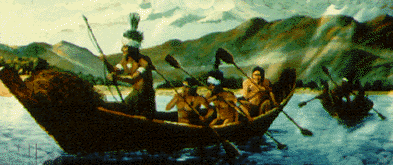|
|
Canku Ota |
|
|
(Many Paths) |
||
|
An Online Newsletter Celebrating Native America |
||
|
September 22, 2001 - Issue 45 |
||
|
|
||
|
Paddling in the Waters of Time |
||
|
by Eric Firpo Newspress Staff Writer-September 6, 2001 |
 It's been about
150 years since the sight of Chumash Indians paddling a plank canoe to the Channel Islands was a common occurrence. It's been about
150 years since the sight of Chumash Indians paddling a plank canoe to the Channel Islands was a common occurrence.Now a group of Chumash from the tricounties will try to make that an annual sight -- and just possibly, a regular one. In Saturday's predawn calm, Chumash paddlers cradled in a traditional tomol will leave Oxnard's Channel Islands Harbor, embarking on a 20-mile trek to Santa Cruz Island. About 21 people will take turns muscling a five-person tomol through the open waters, first to Anacapa Island and then to Santa Cruz Island. There, about 150 Chumash from a handful of bands up and down the coast will kick off a mostly private weekend of camping, storytelling and singing. "The main thing is to get our young people back in touch with maritime culture," said one of the event's organizers, Dennis Kelley, 39, a board member of the nonprofit Chumash Maritime Association, one of the trip sponsors. "We want to improve their connection to their culture .Ê.Ê. and get Chumash families together to celebrate their heritage." For two millennia, the tomol was a big part of it, according to historians. Made of redwood planks, lashed together with the dead roots of a wetland shrub and sealed with a waxy mixture of natural asphalt and pine pitch, the boats were the creme-de-la-creme of Chumash seafaring culture. The tomol was more expensive to build than their huts back then, and nearly as valuable, according the late Santa Barbara anthropologist John Harrington. Of course the tomol facilitated trade between mainland and island tribes. But more than that, "its main purpose was as a fishing vessel," said John Johnson, curator of anthropology at the Santa Barbara Natural History Museum. One boat with a five-man crew could haul in enough fish to feed 40 people, he said. Sardines were apparently the staple, but Chumash fishermen also caught swordfish. On Saturday a tomol called "Elyewun" -- Chumash for swordfish -- will be used in what is likely the first such crossing since the 1800s. Built a few years ago and stored at the Santa Barbara Maritime Museum, the Elyewun is a 20th century version of a tomol. It's made of redwood, but tied together with nylon cord, said Mr. Kelley, who's part Chumash but not a Santa Ynez Band tribal member. Also, in case of leaks, there will be a bilge pump on board in place of the old-fashioned Chumash method -- a bailing crew member. The crossing is not without risk -- tomol accidents and sinkings were hardly uncommon, and according to Mr. Harrington's research, the Chumash rarely ventured out in rough seas. Mr. Johnson even said there's evidence night-time channel crossings were preferred because of a normally placid midnight sea. Mr. Kelley spent the past few days lining up two chase boats to accompany the tomol, as well as floatation devices and other safety equipment for paddlers -- just in case. During the crossing, crew members will rotate between the chase boats and the tomol. |
|
Native American Watercraft-Tomol |
|
Chumash Indian Life |
|
|
||
|
|
||
| Canku Ota is a free Newsletter celebrating Native America, its traditions and accomplishments . We do not provide subscriber or visitor names to anyone. Some articles presented in Canku Ota may contain copyright material. We have received appropriate permissions for republishing any articles. Material appearing here is distributed without profit or monetary gain to those who have expressed an interest. This is in accordance with Title 17 U.S.C. section 107. | ||
|
Canku Ota is a copyright © 2000, 2001 of Vicki Lockard and Paul Barry. |
||
|
|
|
|
|
The "Canku Ota - A Newsletter Celebrating Native America" web site and its design is the |
||
|
Copyright © 1999, 2000, 2001 of Paul C. Barry. |
||
|
All Rights Reserved. |
||
